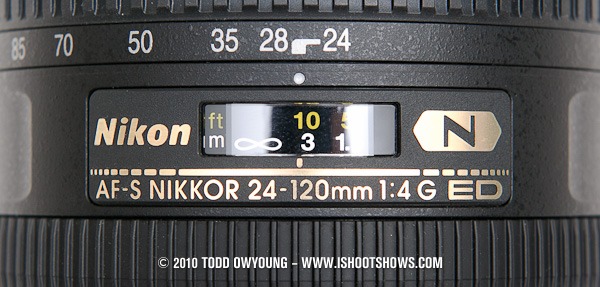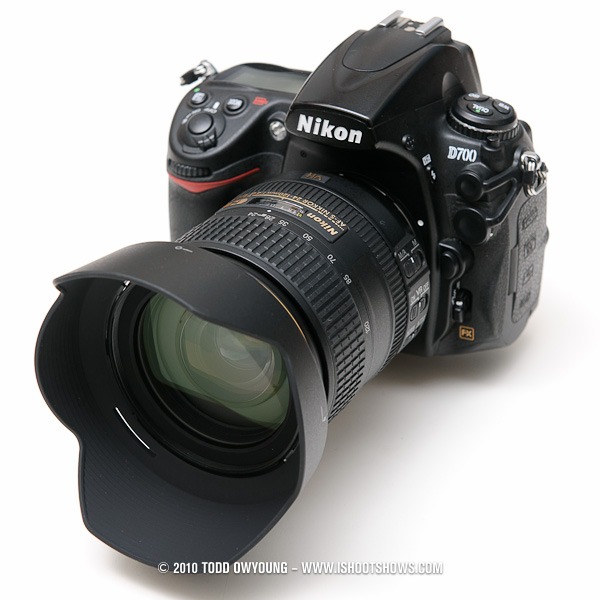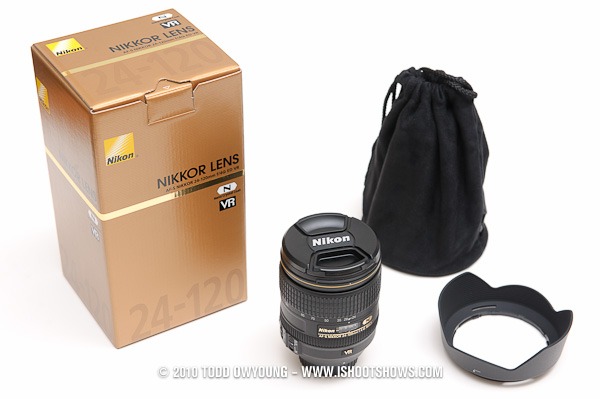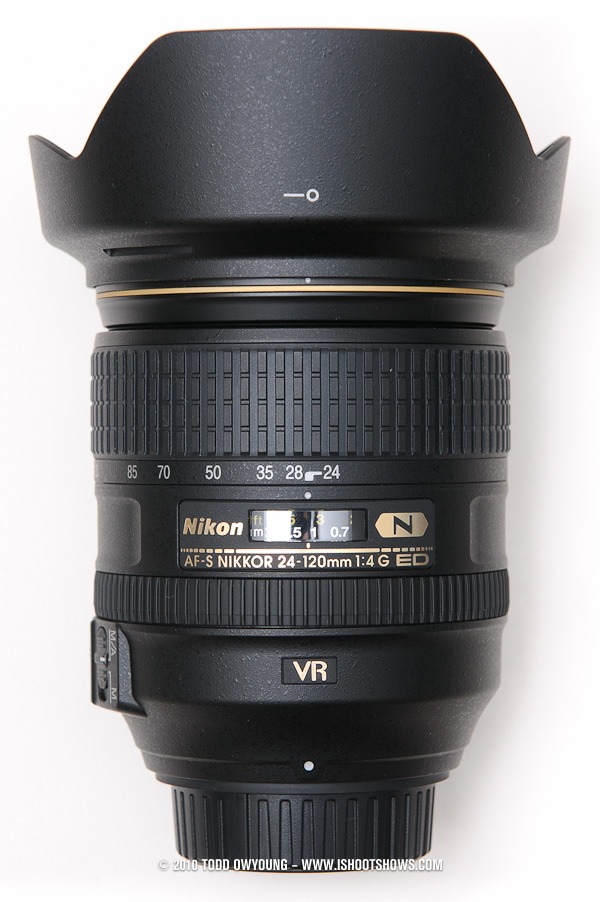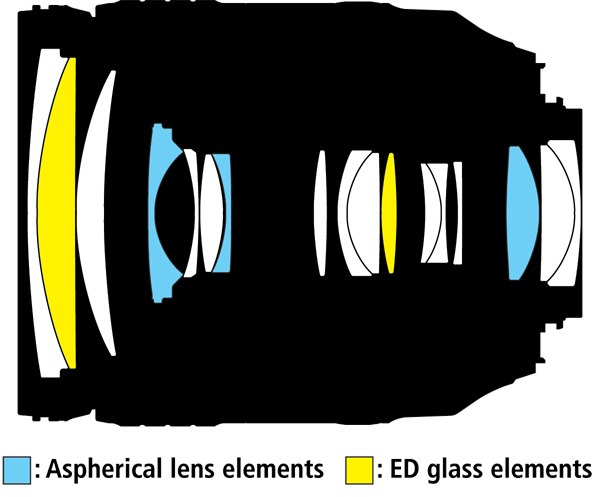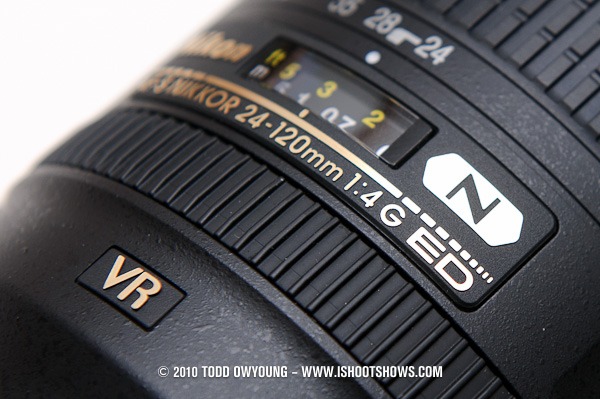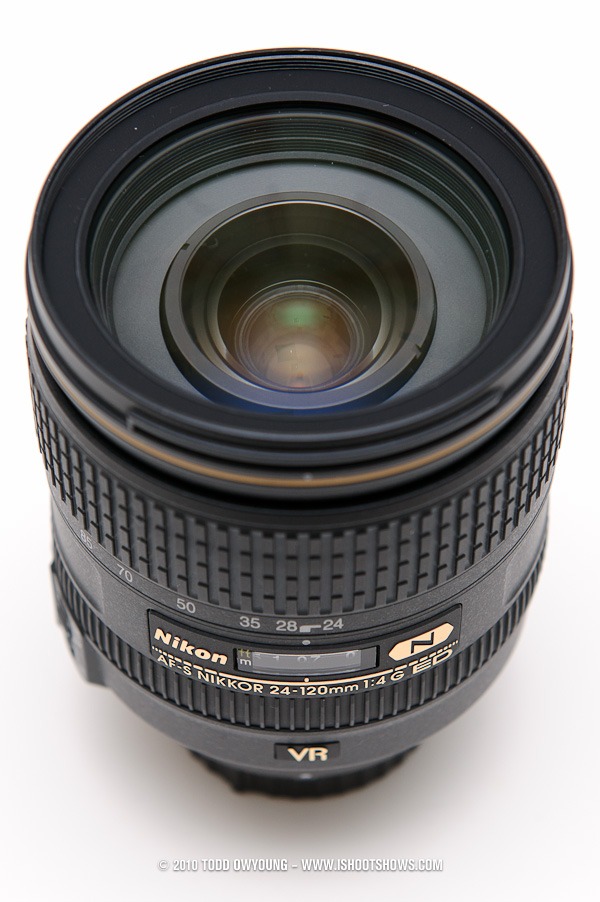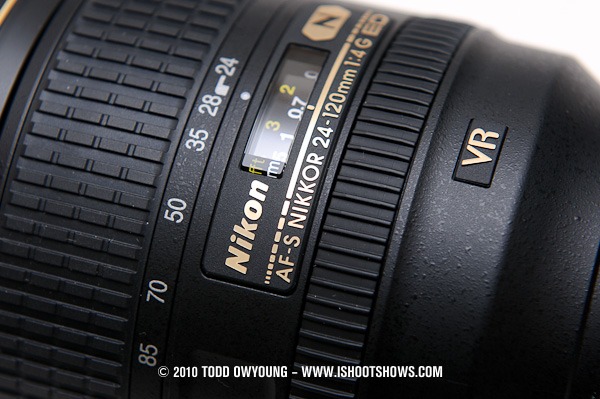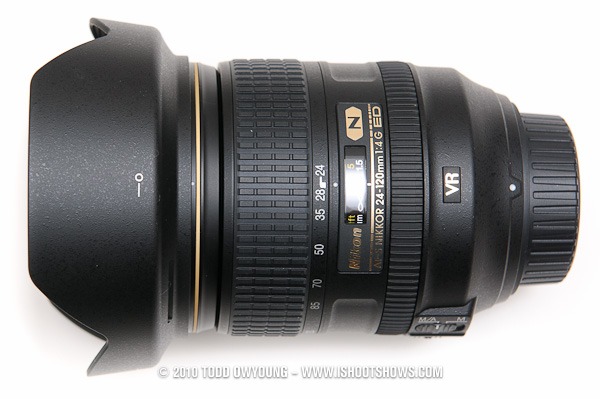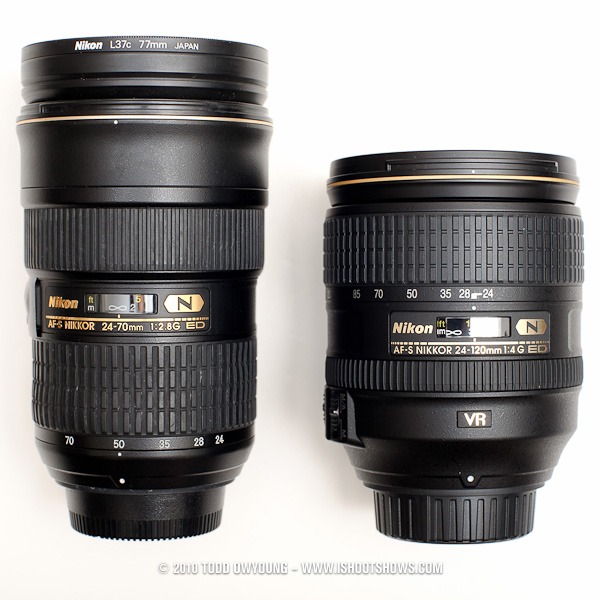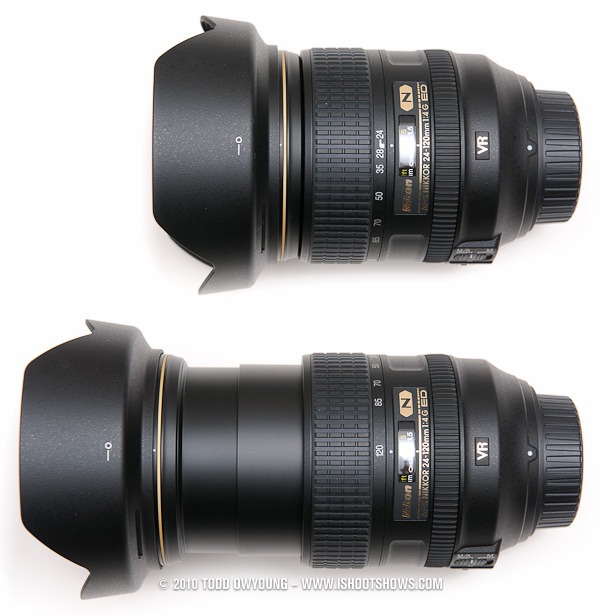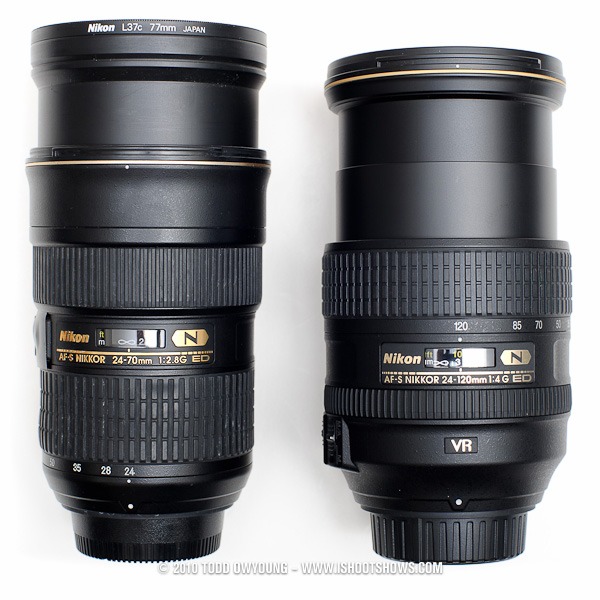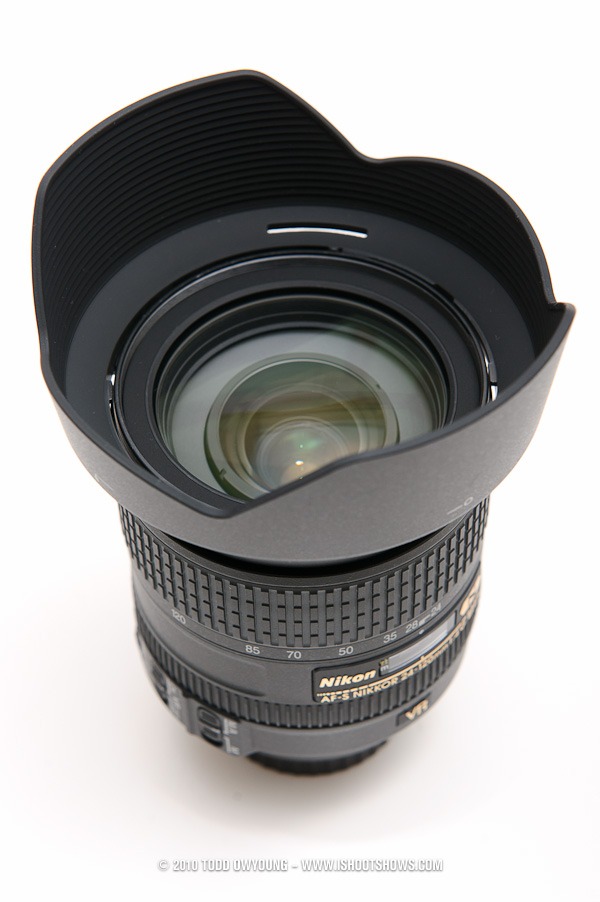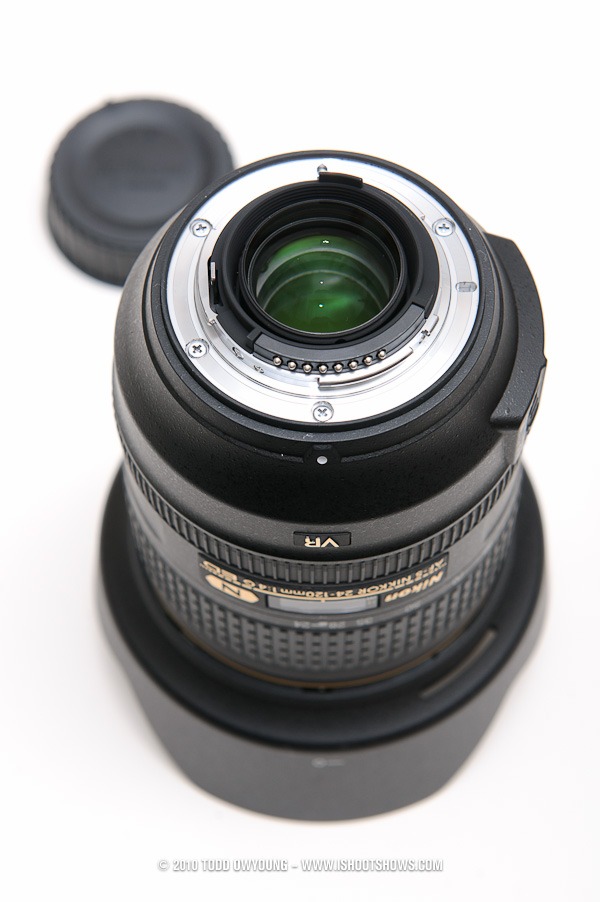Five-years after the release of Canon's popular 24-105mm f/4 L zoom, Nikon has finally thrown a wide-range, constant-aperture contender into the ring: the Nikon 24-120mm f/4 VR.
Following the introduction of the Nikon 16-35mm f/4 VR, Nikon's new wide-angle to telephoto 5x zoom packs a hugely useful range into a compact form factor. However, all the convenience in the world won't make up for compromised optics – let's see how this new zoom stacks up.
A detailed review with plenty of sample images after the jump.
The Nikon 24-120mm f/4 VR tested in this review was provided by B&H in NYC. If you find this review helpful, please consider buying your next photo gear purchase from B&H, Amazon.com, or any of my other my affiliate links. To learn how you can help support www.ishootshows.com, visit the page Buy Yourself Something Nice. Now with that out of the way, let's get to the review.
What's In The Box
In the box, the 24-120mm comes with a soft cloth lens pouch, lens hood, owner's manual and warranty card. Once nice thing to note is that packaging is basically all cardboard – no polystyrene foam, so Nikon's looking pretty eco-friendly in this instance.
Unlike the “pro” f/2.8 zooms, it is interesting to note that the lens pouch isn't more heavy-duty nylon case like the one that ships with the Nikon 24-70mm f/2.8. That said, I never use these cases anyway, as they're either in a real camera bag or in use.
Features
24-120mm Range
Just like the Canon L lens, the new Nikon features a constant f/4 aperture. However, rather than just match Canon's specs, Nikon has upped the ante with an extended zoom range of 120mm at the telephoto end.

For me, this added reach makes the lens just that much more usable as a single-lens solution. In particular, the long end of the zoom works fantastically for portrait work. But more than pure reach and compression, the added focal length gives you the flexibility to produce a more defocused background compared to a shorter lens – which is especially welcome due to the f/4 aperture.
Constant f/4 Aperture
The 24-120mm range isn't anything new in Nikon's lineup – the old variable aperture Nikon 24-120mm f/3.5-5.6 VR was in the lineup for years – but what's exciting with this new lens is the constant f/4 aperture.
For my work, this constant aperture carries a huge advantage over a variable aperture zoom (such as a f/3.5-5.6 lens) when working at wide apertures. The main benefit for me is being able to shoot freely in manual mode without having to worry about a change of exposure as I change the focal length.
With a variable aperture lens like the old 24-120mm f/3.5-5.6, the maximum amount of light falling on the sensor is dependent on the focal length. So while shooting at 24mm the max aperture is a relatively bright f/3.5, that quickly narrows until you're locked at f/5.6 at the telephoto end of the zoom.
The new 24-120mm lens gives a constant aperture of f/4 throughout the range, meaning that it's possible to shoot wide open at the same exposure, regardless of zoom – something impossible with a variable aperture lens.
In addition, while it's a stop slower than the standard f/2.8 pro zoom, this smaller constant aperture means a more compact design and the ability to extend the zoom range while still keeping the lens relatively small.
Nano Coating
I've said it before and I'll say it again. I love Nikon’s Nano Crystal Coating. It's like bacon – it just makes everything better. Nikon's new proprietary coating may just be marketing hype, but I have to say it's working, because every lens that's been spanked with Nano has delivered beautiful color and contrast, even in tough lighting situations.
On paper, Nano coating is a multi-coating that reduces ghosting and flare. But together with the new optical designs Nikon has been rolling out, this new generation of lenses just has a fantastic quality that I love. Beautiful, natural contrast that's more like looking at reality than an image.
VR II Technology
With the new zoom, Nikon has implemented its latest generation of Vibration Reduction techonology, VR II. Nikon states 4-stops of stability with the new VR, over 3-stops with the previous generation.
What this advantage means, in theory, is that you'll be able to shoot handheld at lower shutter speeds than you would without VR, with up to 4-stops of stabilization. So if you can shoot at 1/200 without camera shake when shooting handheld (without a tripod), then VR may compensate down to 1/13 shutter speed. In theory.
In practice, what I've found is that VR acts more like a guardian angel. You're probably not going to want to push VR to the limit for critical work, but it will save your butt from time to time in ways you probably can't imagine.
However, with a slower f/4 lens like the new 24-120mm, VR comes into play just a little more regularly, making up a stop or two of shutter speed for when the light starts to drop. And at it's best, VR pretty much just works in the background. I generally shoot with VR activated all the time – set it and forget it.
Design & Usability
Ergonomics & Design
Overall, the design of the new Nikon 24-120mm f/4 VR is compact considering the wide 5x zoom range. The lens is roughly the same size as the new Nikon 85mm f/1.4 , and has a pretty decent heft in the hand.
The lens is designed with the manual focus ring closest to the lens mount, while the zoom ring is near the front of the lens. This is backwards compared to Nikon's f/2.8 zooms, so this configuration may throw off some users.
The downside of this configuration is that you have to extend you fingers farther to manipulate the zoom ring. Unlike the Nikon 24-70mm f/2.8, it's not possible to easily cradle the camera body and change the zoom with the 24-120mm. At least for me, my hand has to move forward too much to offer much support.
In this comparison shot of the Nikon 24-70mm f/2.8 and the new 24-120mm f/4, you can see how much closer the zoom ring on the 24-70mm is to the mount compared to the 24-120mm.
While I'm sure there are mechanical reasons for Nikon's decisions here, I would have loved to see the zoom ring and focusing collar's positions reversed.
Switches
The switches on the side of the 24-120mm are pretty standard – a M/A -M switch at the top to toggle between Autofocus with Manual override or Manual focus-only, VR, and then a VR mode selector for normal or active operation.
As I mentioned in the Nikon 70-200mm VR II review, unless you’re shooting from a car, helicopter, or other wildly moving position, the normal VR mode is going to yield the best results.
Zoom
The zoom function of the lens is a double-extension mechanism, with two nested barrels that extend from the main lens body. To give you an idea of the kind of extension you're going to get with the 24-120mm, here's a comparison at 24mm (collapsed) and 120mm (extended).
For reference, here's the 24-70mm next to the 24-120mm to show you the maximum barrel extension of the two zooms.
As you can see, the Nikon 24-70mm f/2.8 features a longer, more tapered lens barrel and more overall extension. However, one important thing to keep in mind with this comparison is that the 24-70mm's hood attaches to the lens body, while the 24-120mm's hood attaches to the end of the front element.
So in practice, you have a known quantity with the 24-70mm when using it with the lens hood. With the 24-120mm, the overall length of the lens changes more dramatically, as the lens hood isn't fixed to the body.
Unlike cheaper lenses, I never experienced any zoom creep with the 24-120mm while shooting with it.
Lens Hood
The lens hood isn't terribly deep, but it is wide. Due to the wide range, it's not going to be all that effective at the telephoto end of the lens.
The hoof for the 24-120mm attaches via a friction lock, and once it's on, it's solid. The only real reason to take off the hood is because it's so wide, but for this sort of lens I prefer to just leave the hood attached and in the shooting position at all times.
Build Quality
Considering the double-barreled zoom extension, the lens feels surprisingly solid even when racked out to 120mm. While shooting with the lens, I didn't experience a hint of zoom creep – only time will tell how this design will hold up, but this new lens feels solid.
Overall, the build quality is very good. It's a huge step up from consumer lenses, and the new 24-120mm f/4 is generally in the same league as most of Nikon's nice f/2.8 lenses. But if pressed, I'd say that it's a very slightly more hollow feeling than my f/2.8 trio. I should note that this slightly less dense feeling is not a bad thing – especially as a travel/walk-around lens.
Performance – Range
What's the mission statement of the Nikon 24-120mm f/4? Probably something like, “The Nikon 24-120mm f/4 is the best travel & walk-around lens for the pro photographer.” The whole reason for its existence is this beautiful 5x zoom range from a wide-angle of 24mm to 120mm.
So what does this look like? Here are two uncropped sample image shot on the full-frame Nikon D700 showing the range of the lens at its extremes, shot from the same position.
24mm:
120mm:
I have to say, I love the range of this lens. The difference between 120mm on the long end of this 5x zoom compared to the 70mm end of my Nikon 24-70mm f/2.8 doesn't sound like a lot, but it's enough to really make a difference in general flexibility. While I wouldn't necessarily want to shoot with just the 24-70mm all day long, I can confidently say that the 24-120mm range is just about perfect for my kind of travel shooting.
Performance – Image Quality
A 5x f/4 zoom isn't going to do anyone any good if it's made out of Coke bottles. Let's get to the goods: image quality. And, the character of that quality.
Color & Contrast
Is it the optical design? Is it the Nano coating? I don't know. But whatever Nikon is doing, it's working. I'm drinking the Kool-Aid. Overall, the color and contrast of the 24-120mm looks great.
Nice blacks, saturated colors, and overall a beautiful pop without edging into heavy-handedness. Wide-open, stopped down, it's all good.
Defocusing Quality
News flash: You don't need fast primes to get a nice background blur for subject isolation. But it does help.
The good news? At 120mm and f/4, you can produce a nice, shallow depth of field with this lens that is going to be quite nice for isolating a subject against a background.
The bad news? The character of the circle of confusion rendered for those defocused elements isn't terribly smooth. That said, for a 5x zoom with an f/4 aperture, the Nikon 24-120mm f/4 doesn't do so badly – with 17 lens elements in 13 groups, there's a lot going on.
But when compared to the Nikon 70-200mm f/2.8 VR II or even the Nikon 24-70mm f/2.8, the new Nikon 24-120mm f/4 is going to add more “character” to the background, as strong lines and specular highlights tend to be rendered with a slightly harder edge.
It's worth noting here that for all the buzz the word “bokeh” receives, the defocusing quality of a lens is just another aspect of its character. Some lenses render out of focus elements smoothly, others harshly. Neither look is inherently better or worse, nor is one suited every image. If you're a fan of limp, mushy bokeh, the 24-120mm f/4 isn't for you – but you knew that already.
Image Performance – Close Focusing
With a maximum magnification of 0.24x, or a ratio of about 1:4, the Nikon 24-120mm f/4 gives you some pretty decent close-up options for a walk-around lens, which is quite nice. While shooting with this lens, I was constantly surprised by how close the lens would focus – 45cm (1.5′) throughout the range.
What this close focusing ability means for every day use is a pseudo “macro mode” that is fantastic for smaller details – especially nice at 120mm.
We're not exactly talking macro-territory for close-ups, but I love the fact that this lens gives such a nice close-up ability. For travel photographers who don't want to carry around a dedicated close-up lens for details (or, more likely, who would forgo one altogether), this is a great feature.
Image Performance – Distortion
If I were to list one single flaw that might limit the 24-120mm f/4 for my own use as a travel lens, I'd have to say that it's the distortion of the lens.
The saving grace of the lens, however, is that the distortion is relatively easy to correct in an editing program like Adobe Lightroom.
 |
 |
On the left, is the uncorrected image. On the right, I've applied lens corrections in Adobe Lightroom to adjust for the geometric distortion of the lens.
Image Performance – Sharpness
For the 5x zoom range it offers, the 24-120mm f/4 offers great sharpness. In my shooting, I found the center square of the frame solid even at f/4. The corners of the frame are a little weak wide open if you're looking for crisp, edge to edge sharpness – naturally, stopping down helps.
Closed down, the image evens out, just as you'd expect. For actual photographers who understand that even great tools necessitate compromise, the 24-120mm f/4 is sharp enough that you should be too busy making great images and not crying over a little corner smudging.
That said, here's a sample image shot at 52mm at ISO 200 that is sharp edge to edge on the Nikon D3. I don't think that even the pickiest shooters would find too much fault with the image quality here. Go ahead, download the full-res file.
In my shooting, I did find that the middle of the range produced the most blisteringly sharp results.
The 24-120mm As Portrait Lens
If you're looking to use the new 24-120mm f/4 as a portrait lens, I can confidently say that the range for portraiture is pretty excellent.
My preferred portrait range is 85-135mm, which overlaps pretty well with the range of this zoom. As a studio lens, I could see the 24-120mm working beautifully, but I found that it works quite well wide open as a portrait lens, too.
Other Sample Images
Just like all the other images in this review (excluding the shots of the 24-120mm itself), these images were all shot with the Nikon 24-120mm f/4 VR.
Summary
As camera manufacturers continue to extend the usable range of ISOs suitable for even critical work, the f/4 zoom begins to blur the distinction between pro-grade zooms.
While Canon has long had f/4 options with their 17-40mm f/4 L, 24-105mm f/4 L, and 70-200mm f/4 L lenses, Nikon shooters have traditionally had to pick between slower, variable aperture zooms or pro-grade f/2.8 zooms. The new Nikon 24-120mm f/4 VR changes that completely.
In my use of the new Nikon 24-120mm f/4 VR, I can say that this lens redefines my definition of a walk-around lens. For Nikon shooters, there's hardly a better combination of performance and range in a full-frame lens.
As a relatively compact walk-around lens, the 24-120mm offers what I'd consider very good performance compared to professional f/2.8 zooms, though not without its compromises. However, for all its trade-offs, I think that this 5x zoom offers such flexibility that it may be the very best pro-level travel lens to date, with a range and overall image quality that bears serious consideration for anyone looking for quality in a more compact form factor than f/2.8 counterparts.
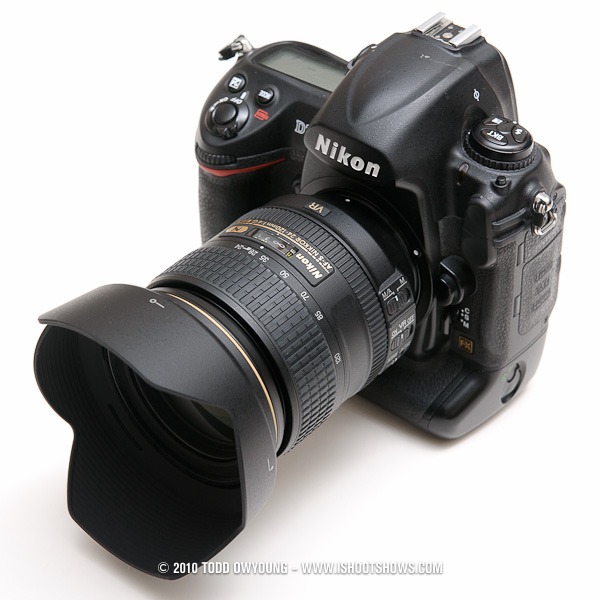
Where To Buy
The Nikon 24-120mm f/4 VR tested in this review was provided by B&H in NYC. If this review and other content on www.ishootshows.com was helpful to you, please consider supporting this site and purchasing your photo equipment at B&H through any of the affiliate links in this review or below:
If you do buy through B&H or any of my affiliate links, drop me a line! I’d love to hear about what you picked up. B&H is where I personally buy the vast majority of my gear, and I’m looking forward to bringing you more reviews thanks to their equipment loans.
Questions? Comments?
Do you have questions about the new Nikon 24-120mm f/4 VR II? Let me know.
If you have the new Nikon 24-120mm f/4 VR II?, what do you think of it? Chime in and have your say!

